How to Build a Survival Shelter

Being a “survivor” has captured the imagination of millions of TV watchers. But a survivor is much more than a TV fantasy. A survivor is someone prepared to live—and live as healthfully as possible—when life far from home doesn’t go exactly as planned.
Being prepared to survive in the outdoors starts with knowing what to be prepared for. You can live days without water and weeks without food. People who don’t survive in the outdoors most often die from losing their body heat, not necessarily from starvation or dehydration. You need to be able to start a fire. And perhaps most importantly, you need to be able to build a shelter to stave off wind, rain and snow, and to keep your body heat trapped where it belongs: near your body.
Here are the keys to taking shelter in the wilderness:
DRESS WISELY
Your first line of defense against the elements is the “shelter” you choose to wear. If you wear layers of synthetic material or wool, and carry a shell of windproof, waterproof material, you are ready for anything. You’ll trap your body heat instead of expending it on the outside world.
THE RIGHT SPOT
Choosing the best place to build a survival shelter is important. It should be in the driest spot you can find. Nothing sucks out body heat faster than wetness. If it isn’t too cold, build a shelter on high ground. Breezes will help keep the bugs away, and you’ll be easier to see if a search party passes nearby. If a cold wind is blowing, choose a spot sheltered by trees. But don’t build in the bottom of deep valleys or ravines where cold air settles at night.
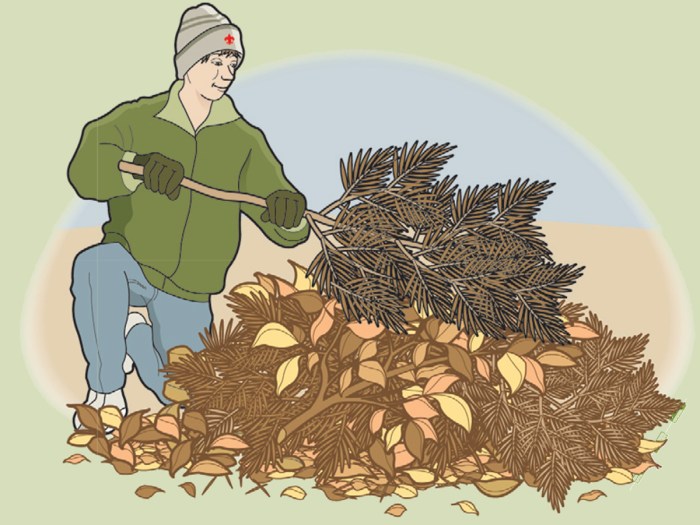
THE COCOON
If it’s almost dark and you can hurriedly collect dry debris (leaves, pine needles, bark) from the forest floor, make a pile two or three feet high and longer than you are tall. When you burrow into the pile, you are in a natural sleeping bag that protects against heat loss.
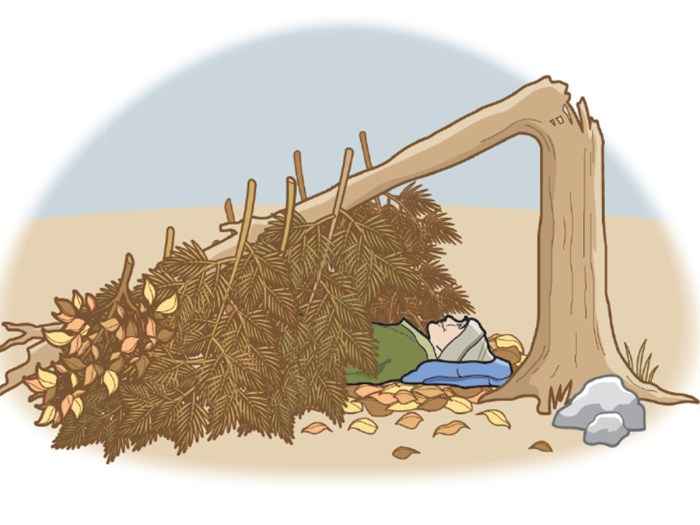
THE FALLEN TREE
The simplest shelter is a fallen tree that has enough room under it for you to crawl in. Lean branches against the windward side of the tree (so the wind is blowing into it and not against it) to make a wall. Make the wall thick enough to keep out wind. If you can build a fire on the open side of your shelter, the heat will help keep you warm.
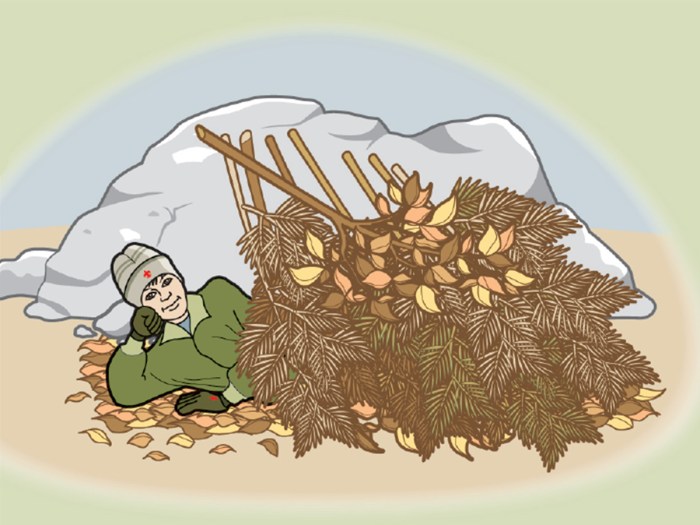
THE LEAN-TO
If you find a fallen tree without enough room under it, or a rock or a small overhang, you can build a simple lean-to. Start by leaning fallen limbs against the object, such as the top edge of an overhang, to create a wall. Lean the limbs at an angle to help shield rain. Cover the leaning limbs with leaves, boughs, pine needles, bark or whatever the forest offers. When you have built a thick wall, you can crawl underneath into your shelter. Remember to make your shelter no bigger than you need to fit you and anybody else with you. The bigger the space, the harder it is to keep warm.
You can also build a lean-to by placing one end of a long stick across a low limb of a tree and propping up the other end of the stick with two more sticks. Tie the ends of the sticks together with your boot laces or belt. Lean more sticks against the horizontal stick. Then pile leaves and other forest debris against the leaning sticks until you have a wall. Once again, a fire on the open side of the lean-to will add much heat to your “room.”
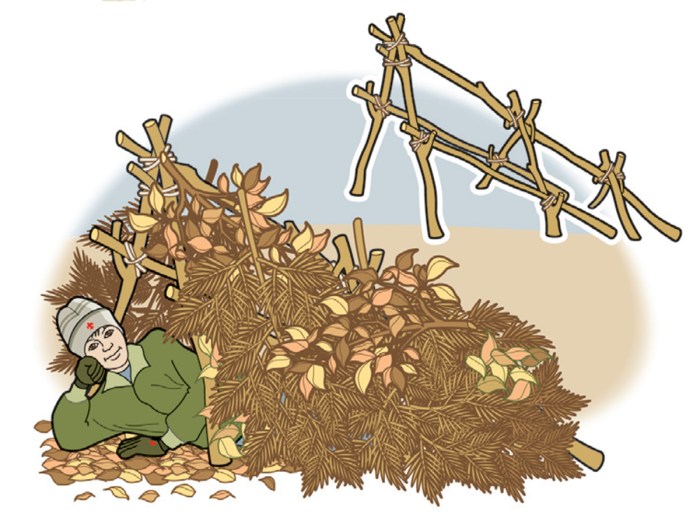
THE A-FRAME
If you can’t make a lean-to, you can make an A-frame shelter. You’ll need two sticks four or five feet long and one stick 10 to 12 feet long. Prop the two shorter sticks up in the shape of the letter A. Prop the longer stick up at the top of the A. Tie the three sticks together where they meet. The three sticks will be in the shape of an A-frame tent with one end collapsed against the ground. Now prop up more sticks against the longer stick, and pile forest debris against the sticks until you have an insulated shelter open at the high end.
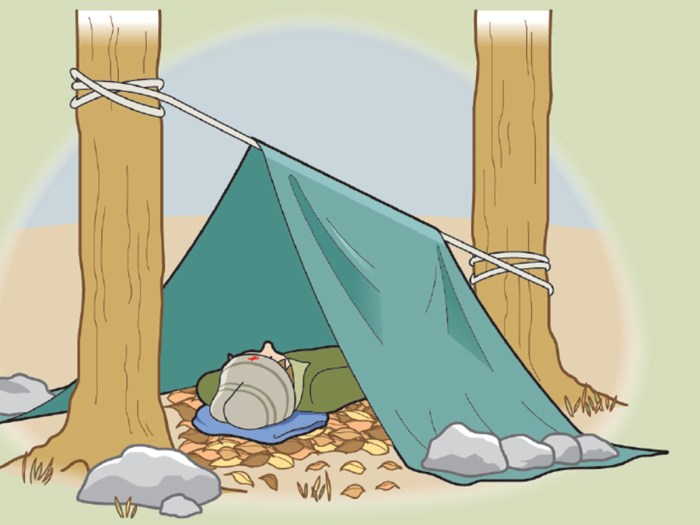
A TARP
When you have a tarp, sheet of plastic or Space Blanket with you, and some rope or cord, tie a line between two trees. Tie it low to the ground with just enough room for you to lie beneath. Stretch the tarp over the line. Place large rocks or logs on the ends of the tarp to hold it in place with the edges close to the ground. If it’s snowing, tie the line off higher on the trees. Steeper walls will shed snow better. Now you have an emergency tent.
YOUR BED
Your shelter is not complete until you have made a bed to lie in. Dry leaves work well. Make your bed a little bigger than the space your body covers and at least eight inches thick. When you snuggle into it, you are ready for the unexpected night out.
BAD PLACES TO BUILD A SHELTER
1. Anywhere the ground is damp.
2. On mountaintops and open ridges where you are exposed to cold wind.
3. In the bottom of narrow valleys where cold collects at night.
4. Ravines or washes where water runs when it rains.
not helpfull
As someone who is reading this from a crashed plane, thank you for your help.
Thanks so much for the advice on this report!👍😁
That helped me
Thanks for your help.😁
thanks a lot guys
good info thx
I love the outdoors and I love survival but I always build big shelters so this was helpful
thanks i will us this!
I love this
Im Reading Hatchet. Its Good So Far.
I love this
Thats pretty good
what about a tree house
Nice
This was very helpful information and I will use it thank you
Very Good
Thanks for the info!
thx
this the best
i problably wont need to use this in life but very hepful in case i do!
thx for this
i need help
I love the woods its my happy place ive already tried it one way and im hoping to do the other one
This information was very helpful, thanks!
thx this is so helpful it will help with girl scouts!! :p
Hello! Thank you so much, this was a very helpful resource to use when I was doing a survival project for school! I think it is very incredible how many ways you can build a shelter, and I also think that this is a very professional website, onlike some others. I appreciate all that has been written in this article! (Yes, I know this is very lenghty, but I am one of those people. :P)
thx
Thank you for the shelters and how to build them.
thx this is so cool and good to know! 😀
this was the helpfullest thig I could find
thx alot
This was really helpful, tanks!
This help me so much, thank you
thanks a lot this will for sure make me get an a.
I would love to do it, but unfortunately i have no trees i managed to make a stick den though from this im only a kid so the fire was out though
thx for helping me in me classwork
this really helped in my classwork thanks
that was so cool I cannot wait to try it out!
hi this really help with school thx lot!!!
thanks alot now i finnaly wanna go outside
nice
I have a woods in my backyard and i just needed tips to improve my fort. Thanks! since im only a kid, im not aloud to bild a real fire (even though i know ALOT of survival tips and how to make many types of fires… I still can’t.)
Anyway, thank you!!!
This was very interesting! Now I want to go outside and build a fort!
This really helped with my survival project. Thanks!
Thanks this will really help with my survival project! 🙂
This helped me with my project thx
i am doing a report and a lot of my project came from this website
thx this helped me with school
um really why did you have to make it boys life. this kind of stuff is literally my life. i love building shelters and being outside in the wilderness. it is a boys and girls life. think about that.
does it really matter?
agreed
Hello! I don’t think the creator of the orginization mean’t to offend any women, and I would think that they know that males and females can both love “outdoorsy” things, such as this. I don’t see the need to offended.. (This is just my personal opinion. 🙂
good shelter
i cant bevieve how much i can learn from this website in less than two minutes
this is great i learned so much
thx this helped with my project 🙂
this is a really good thing to show people how to build shelter
i don’t know it’s hard
yes it is
yeet